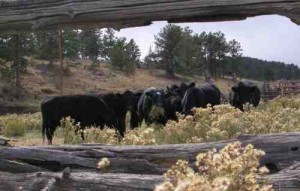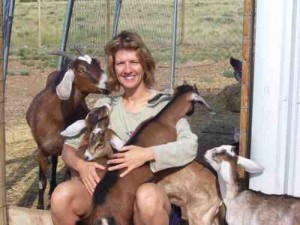Column by George Sibley
Horology – January 2008 – Colorado Central Magazine
HEADING INTO THE Year of Our Fear 2008, there are lots of things I think I ought to be writing about: railing on the spineless Congress that’s letting a power-mad administration gut the Constitution; wondering why all our “serious” presidential candidates are letting themselves be forced into a counterproductive Bushian mold of macho toughness; wondering how we are ever going to restore some kind of balance between private wealth and the commonwealth — et cetera.
But instead, I find myself thinking about the solstice — not just a day but this two-moon period of long dark nights we’re in.
This digression, from things I can’t do much about to things I really can’t do anything about, is the fault of a friend up in Crested Butte, a guy who likes to get up in the winter pre-dawn and skin up a mountain in order to ski down it in the dawn’s early light. He was wondering why, after the solstice when the days start getting longer again, the sun continues to come up a little later every day for almost three more weeks. This year, for example, not until January 9 will the sun actually come up earlier than it did the day before.
A little Internet research gave me an answer of sorts. Forget clock time; it’s too idealistically precise to measure what’s really happening between earth and sun. I learned that 24 hours (86,400 seconds) is only a good average for the time it takes for the earth to do a full rotation. In reality, that rotation is continually slowing down or speeding up a little — not much, just milliseconds, but over time little changes accumulate. I learned there is an International Earth Rotation Service, created and supported by astronomy associations and institutions all over the world, which keeps track of these changes, and every few years adds a “leap second” to get the world’s clocks more in sync with what the planet is actually doing.
So why is the planet not spinning regularly — 86,400 unvarying seconds per revolution? Earth scientists hypothesize a relationship between the weather on earth and the earth’s rotation. Turbulent weather — moving high and low pressure systems — correlates with slower rotation; the rotation slows for the northern hemisphere’s winter months, for example, a time when there tends to be considerable weather turbulence. Does the rotation slow because of the turbulence, or does a slower rotation precipitate more turbulence? Both theories have their proponents, and intuition suggests a complex feedback process between the two.
But it’s hard to know where to stop in Getting Informed since questions multiply faster than answers, and that little exploration led seamlessly into discussion of a similar correlation scientists draw between weather patterns and the planet’s tendency to “wobble” around its axis. Huh? The earth wobbles as it rotates? Anyone who ever played with a top or a gyroscope understands “wobble” — and what it ultimately means when your top starts to wobble.
THESE LITTLE WOBBLES related to weather changes — and maybe earthquakes — have only been discovered since we’ve had the satellites as “outside observers,” but we’ve long known that the planet wobbles (changes its angle between the north-south axis of rotation and the “orbital plane” of our orbit around the sun) in some larger slower cycles. There’s the 25,800-year “precession of the equinoxes” wobble whereby the axis scribes a slow circle in the sky, pointing now at the “pole star” called Polaris, but eventually at Vega instead, and in a few thousand more years at some other star.
There’s some degree of scientific consensus that this wobble is related to the earth’s equatorial bulge. Huh? Yes, the fact that the diameter of the earth at the equator is something like 43 kilometers more than its diameter through the pole axis. Which, come to think of it, is about what you might expect from something rotating at a speed, at the equator, of more than 1,000 miles per hour; the centripetal force of gravity still manages to hold the earth together against the centrifugal force at that speed trying to pull the planet apart, but it can’t prevent some bulging.
THEN THERE IS the further fact that the earth’s axis goes through another longterm tilting process with respect to its orbital plane, ranging from 21.5 degrees to 24.5 degrees from the vertical. We are currently tilted about 23.5 degrees, on our way to about 22 degrees some nine or ten thousand years down the road, when we can expect warmer winters and cooler summers. This cycle of tilting repeats every 41,000 years and obviously influences the variations in seasons.
All of these somewhat independent cycles of wobble of course affect each other — either damping each other down in interference patterns, or reinforcing each other in what we can intuitively imagine are potentially dangerous resonances — the most obvious being the convergence of cycles that buries part of the planet in ice.
And that is all just the irregularities in our rotation around our own axis. Then there are the irregularities in our rotation around the sun. Like the eccentricity of the orbit: currently our orbital path around the sun is very close to a circle, but on a 100,000-year cycle, the orbit stretches out into an ellipse with a long axis several million miles longer than the short axis — a change that causes variations in solar gain to the planet overall through the orbital year of more than 20 percent.
And then there’s that orbit itself, our 584.57 million-mile annual journey around the sun, a journey which, on a cruise-control speed of a little more than 66,500 miles per hour, we complete in — 365-1/4 rotations. What? That’s right: we’re about one fourth of the way into a 366th rotation when we “pass go” and start a new year of rotations around the sun. Which is why every four years, including the one coming up, we have to add a day to the calendar. But because it is not exactly one-fourth of a rotation, but is a little less, every 2,000 “leap cycles” we’ll need to not add the “leap day” to the calendar. . . .
So. . . What? Where am I going with this? And what does it have to do with life in Central Colorado? Well, don’t you find all this cumulative . . . sloppiness (I don’t know what else to call it) irritating? Or even a little unsettling? What does all this do to the idea of order? What does it do to that much debated concept of “intelligent design”? Who or what would design a system so full of precarious wobbles, shifty orbits and other imprecisions?
Henry Adams, one of those rare thoughtful 19th century Americans, concluded from the unfolding science of his day that “Chaos is the law of nature; order is the dream of man.” Compared to the religious idea of a perfect world created by a perfect god, there is clearly an element of chaos to nature — which is all the more apparent the closer we look at it. The deists, a churchless faith in Henry Adams’s lineage that included a large number of America’s “founding brothers,” thought of humankind as a kind of self-regulating species that might also function in that capacity for the planet. They thought the more closely we studied and came to understand the “laws” that governed the universe, the better we would be able to make order in our own unruly societies, and also protect the natural order on which we depend. That’s the dream of order that is “the dream of man,” but science seems to suggest that order might be the emerging dream of the universe as well as of humankind.
HOWEVER, if this wobbly lumbering lump of cooling rock we ride on around the sun does not fit into the kind of clockwork order that is “the dream of man,” it is not really chaos either. We are getting smart enough to at least track most of the wobbles and imprecisions, draw correlations with observable events on earth and in the heavens, and make predictions about what it’s cumulatively likely to mean down the road. What we call “chaos theory” is really a new level of scientific assault on understanding “the law of nature” that takes into account the nasty complexity that emerges from multiple dynamic systems constantly (but not necessarily consistently) interacting with each other in patterns of interference and resonance.
It may be too much for our still-evolving brains. But as we go into a “leap year” that is also an election year, I myself take a sort of perverse courage from remembering that we are all hanging onto the side of a wobbling ball aslosh with water and weather, spinning at around 700 miles per hour at Central Colorado’s latitude while hurtling forward at 66,500 miles per hour in a not quite set orbit around a huge nuclear furnace. That doesn’t minimize our human situation; it just gives it a realistic context. Be wary of simple answers to anything.
George Sibley looks for answers from his home in Gunnison, where nothing is simple, especially in the winter.


